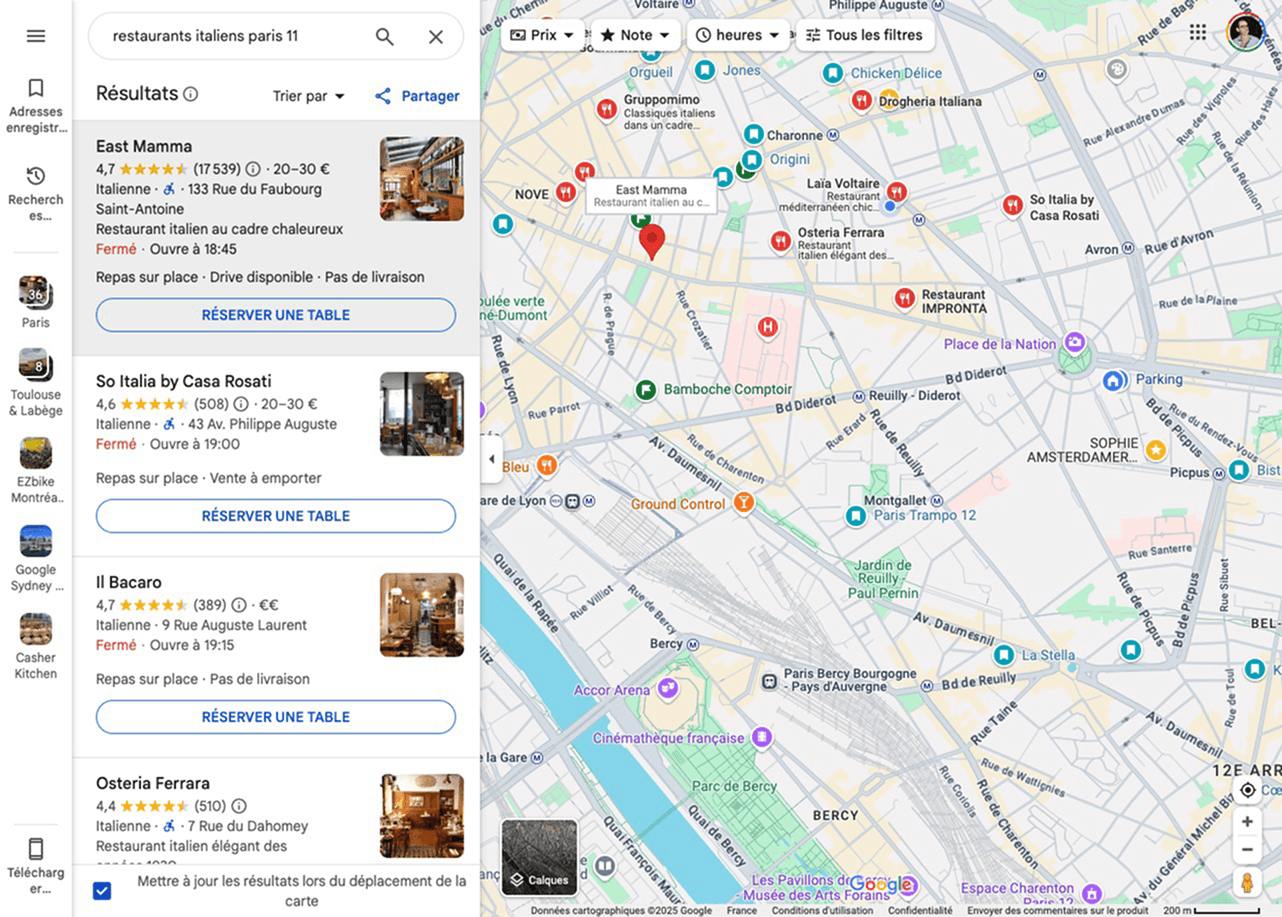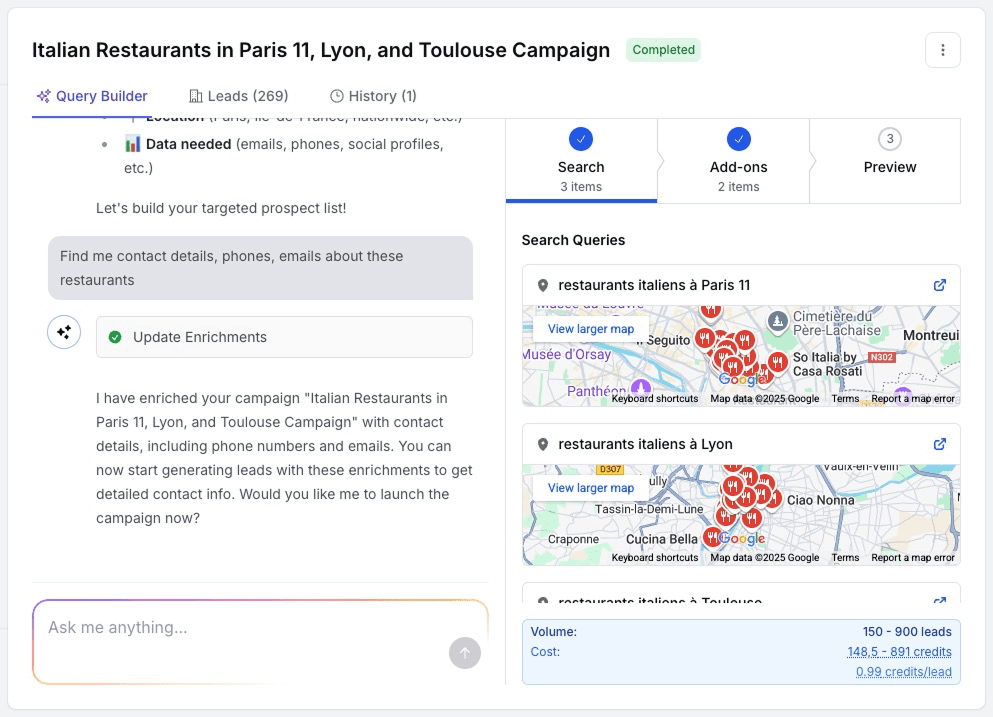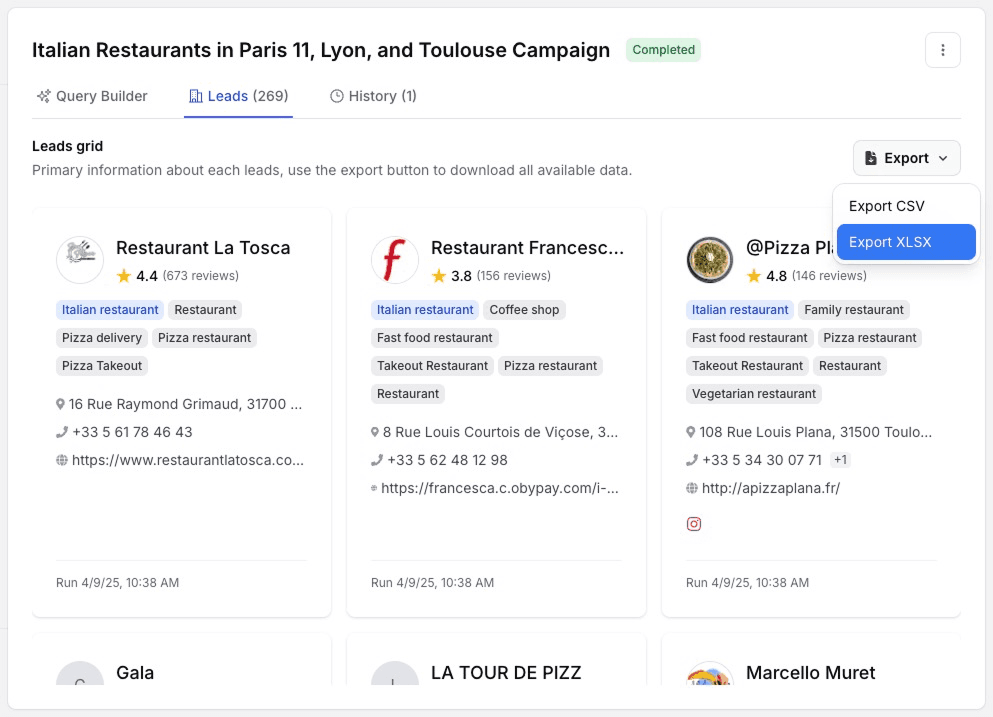The Ultimate Guide to Google Maps Lead Extraction in 2025
Learn how to effectively extract and leverage business data from Google Maps for lead generation. Discover compliant methods, AI-powered tools, and strategies to convert map data into qualified prospects.
Posted by
Related reading
Comparing Business Enrichment Tools: The Ultimate Guide for 2025
Discover how modern business enrichment tools stack up against each other. Learn about key features, pricing models, data quality, and find out which solution offers the best ROI for your specific needs.
How to Generate High-Quality Local Leads for Your Agency
Discover effective strategies and tools to generate qualified local leads for your agency. Learn how to automate lead generation, enrich prospect data, and convert more clients without extensive manual research.
How to Build a Google Maps Business Directory Without Coding Skills
Learn how to create a comprehensive Google Maps business directory without any development skills using AI-powered tools like AskMyBiz that automate data extraction and enrichment.
The Ultimate Guide to Google Maps Lead Extraction in 2025
Google Maps has evolved from a simple navigation tool into one of the world's most comprehensive business databases. For sales teams, marketers, and business development professionals, this vast repository of location-based business information represents an invaluable resource for lead generation. However, effectively extracting and leveraging this data requires specialized knowledge and tools.
In this comprehensive guide, I'll explore the most effective methods for extracting, enriching, and utilizing Google Maps data for lead generation in 2025, with a focus on compliant, efficient approaches that deliver high-quality prospects.
Understanding Google Maps as a Lead Source
Before diving into extraction techniques, it's important to understand what makes Google Maps such a powerful lead source:
- Comprehensive coverage: Google Maps contains information on approximately 200+ million businesses worldwide, from large corporations to small local establishments.
- Regularly updated data: Business information is frequently refreshed through Google Business Profile updates, user contributions, and automated verification.
- Rich contextual information: Beyond basic contact details, Maps provides insights on business categories, reviews, photos, operating hours, and more.
- Geographic precision: The ability to target businesses within specific geographic boundaries with pinpoint accuracy.
These attributes make Google Maps an unparalleled resource for organizations seeking to build targeted prospect lists for sales, marketing, or research purposes.
Ethical and Compliant Approaches to Data Extraction
A critical consideration when extracting Google Maps data is ensuring that your approach adheres to legal requirements and ethical standards. Here are the key principles to follow:
- Focus on publicly available information: Only collect data that businesses have explicitly made public, such as names, addresses, phone numbers, and websites.
- Respect rate limits: Avoid excessive requests that could impact service availability for other users.
- Maintain data privacy: Implement proper security measures for stored data and respect applicable privacy regulations like GDPR and CCPA.
- Provide value to prospects: Ensure that your outreach offers genuine value to the businesses you contact, rather than generic spam.
By adhering to these principles, you can build sustainable lead generation processes that respect both legal requirements and the businesses you're contacting.
Modern Methods for Google Maps Data Extraction
The landscape of Google Maps data extraction has evolved significantly in 2025. Here are the leading approaches currently being utilized:
- AI-powered extraction platforms: Specialized tools like AskMyBiz that use artificial intelligence to identify, extract, and structure business data from Google Maps based on specific search parameters.
- Google Maps Platform API (with limitations): Official Google APIs that provide structured access to some business data, though with significant usage restrictions and costs.
- Manual extraction: Direct collection of information through the Maps interface, which is compliant but inefficient for volume requirements.
- Hybrid approaches: Combinations of approved automated tools with manual verification and enrichment to ensure quality and compliance.
For most business users seeking scale and efficiency, AI-powered platforms represent the optimal balance of compliance, cost-effectiveness, and data quality.

Essential Data Points for Effective Lead Generation
Not all Google Maps data is equally valuable for lead generation purposes. Here are the most important data points to extract for maximum effectiveness:
- Business name and category: Fundamental information that helps with segmentation and targeting.
- Physical address: Complete location information including street, city, state/region, and postal code.
- Phone number: Direct contact information, ideally verified for accuracy.
- Website URL: Critical for further research and digital outreach possibilities.
- Rating and review count: Indicators of business establishment and customer engagement.
- Hours of operation: Useful for timing outreach and understanding business operations.
- Place ID: Unique identifier that can be used for tracking and integration purposes.
While basic contact information is a starting point, the businesses achieving the best results are those that collect comprehensive data sets that enable sophisticated segmentation and personalization.
Strategic Targeting for Relevant Lead Discovery
The effectiveness of Google Maps lead generation depends heavily on how precisely you target your searches. Here are advanced targeting strategies that deliver superior results:
- Multi-dimensional search queries: Combining business categories with geographic parameters and additional keywords to find highly specific prospect types.
- Geographic precision targeting: Defining exact geographic boundaries rather than simple radius searches to focus on business districts or specific neighborhoods.
- Competitive proximity analysis: Identifying businesses located near competitors or complementary services to find prospects with specific needs.
- Attribute-based filtering: Using business attributes like "wheelchair accessible," "women-owned," or "open late" to identify businesses with specific characteristics.
The most successful organizations are moving beyond basic geographic searches to develop sophisticated targeting frameworks that identify prospects with high relevance to their specific offerings.

From Raw Data to Qualified Leads: The Enrichment Process
While Google Maps provides valuable baseline information, converting this data into qualified leads requires enrichment with additional data points. Here's the enrichment process utilized by leading organizations:
- Contact discovery: Identifying decision-maker names, direct phone numbers, and email addresses not available in the Maps listing.
- Company intelligence: Adding firmographic data such as employee count, founding year, revenue estimates, and technologies used.
- Digital presence analysis: Evaluating website quality, social media activity, and online engagement to gauge digital maturity.
- Verification procedures: Confirming the accuracy of contact information through validation services to ensure outreach deliverability.
Modern AI-powered platforms like AskMyBiz can automate much of this enrichment process, significantly reducing the manual effort required while improving data quality.
Integrating Google Maps Data Into Your Sales Ecosystem
To maximize the value of extracted lead data, it's essential to properly integrate it into your broader sales and marketing infrastructure:
- CRM integration: Structuring data for seamless import into systems like Salesforce, HubSpot, or Pipedrive with proper field mapping.
- Marketing automation connection: Feeding leads into nurture campaigns with appropriate segmentation and personalization.
- Sales enablement alignment: Providing sales teams with contextual information and insights to improve outreach effectiveness.
- Analytics implementation: Setting up tracking to measure conversion rates and ROI from Google Maps-sourced leads.
Well-implemented integration ensures that the valuable data you've extracted becomes actionable throughout your sales and marketing processes.

Effective Outreach Strategies for Google Maps-Sourced Leads
The unique nature of leads sourced from Google Maps calls for specialized outreach approaches to maximize response rates:
- Location-specific personalization: Referencing the business's location and local market conditions to establish relevance.
- Review-based engagement: Acknowledging positive reviews or addressing common customer feedback themes to demonstrate research.
- Competitive positioning: Highlighting how your offering addresses gaps identified through analysis of similar businesses in the area.
- Multi-channel sequencing: Coordinating outreach across email, phone, social media, and even direct mail for maximum visibility.
Organizations that tailor their outreach specifically to the context provided by Google Maps data typically see 30-40% higher response rates compared to generic approaches.
Measuring Success: Key Metrics for Google Maps Lead Generation
To optimize your Google Maps lead generation efforts, it's crucial to track the right performance metrics:
- Data accuracy rate: The percentage of extracted data points that are verified as correct and current.
- Contact discovery success: The proportion of businesses for which you successfully identify decision-maker contact information.
- Outreach deliverability: Email delivery rates and phone connection rates for the leads generated.
- Response and engagement metrics: The percentage of prospects who respond to initial outreach or engage with content.
- Conversion efficiency: The rate at which Google Maps-sourced leads convert into qualified opportunities and customers.
- Cost per acquired lead: The total investment in tools, enrichment, and human resources divided by the number of qualified leads.
By consistently tracking these metrics, you can identify bottlenecks in your process and make data-driven improvements to your Google Maps lead generation strategy.
Case Study: E-Commerce Service Provider
To illustrate the practical application of these principles, consider this case study of an e-commerce service provider targeting retail businesses:
The company needed to identify independent retailers in major metropolitan areas who could benefit from their specialized e-commerce platform. Their traditional lead generation methods were yielding poor results with high costs per acquisition.
They implemented a Google Maps lead generation strategy with these components:
- Targeted extraction: Used AskMyBiz to identify retail businesses in specific categories across 15 target cities, excluding chain stores.
- Strategic enrichment: Added decision-maker contact information, website analysis, and social media presence to evaluate digital readiness.
- Segmentation framework: Categorized prospects based on digital maturity indicators and business size to customize messaging.
- Personalized multi-channel outreach: Developed tailored sequences combining email, LinkedIn, and phone contact with location-specific messaging.
The results were remarkable:
- Lead volume: Generated 1,800+ highly targeted retail business leads across their target markets in just two weeks.
- Data quality: Achieved 92% accuracy on business information and 78% success rate in identifying decision-maker contact details.
- Engagement metrics: Secured a 34% response rate to outreach (compared to 8% with previous methods) and 21% meeting booking rate.
- Cost efficiency: Reduced cost per qualified lead by 67% while improving lead quality scores by an average of 3.2 points on their 10-point scale.
This case study demonstrates how strategic Google Maps data extraction and enrichment can transform lead generation results when implemented systematically.
Advanced Techniques for Scale and Automation
As your Google Maps lead generation efforts mature, these advanced techniques can help scale your results:
- Campaign templating: Creating reusable search templates for different business categories and geographic regions to quickly launch new campaigns.
- Progressive enrichment workflows: Implementing tiered enrichment processes that add more data points as leads show engagement potential.
- Automated verification loops: Setting up systems to periodically re-verify contact information to maintain data freshness.
- Cross-platform data enhancement: Combining Google Maps data with information from complementary sources like LinkedIn, industry directories, and public records.
- Predictive lead scoring: Developing algorithms that predict conversion likelihood based on patterns identified in historical Google Maps lead performance.
Organizations implementing these advanced techniques are able to scale their Google Maps lead generation while maintaining or even improving quality and conversion rates.
Conclusion: Building Your Google Maps Lead Generation Strategy
Google Maps represents one of the most valuable yet underutilized lead sources available to businesses today. By implementing the ethical extraction methods, enrichment processes, and strategic targeting approaches outlined in this guide, organizations can develop a powerful new channel for high-quality lead acquisition.
The most successful implementations share several common elements:
- Systematic approach: Treating Google Maps lead generation as an ongoing program rather than a one-time project.
- Quality emphasis: Focusing on data accuracy and relevance rather than raw volume of leads extracted.
- Strategic enrichment: Adding contextual data that enables personalization and effective qualification.
- Integration focus: Ensuring that extracted data flows smoothly into existing sales and marketing systems.
As companies increasingly recognize the value of location-based intelligence for lead generation, those that develop expertise in Google Maps data extraction and utilization will enjoy a significant competitive advantage in their marketing and sales efforts.
By following the principles and practices outlined in this guide, you can transform Google Maps from a simple navigation tool into a powerful engine for business growth and customer acquisition.